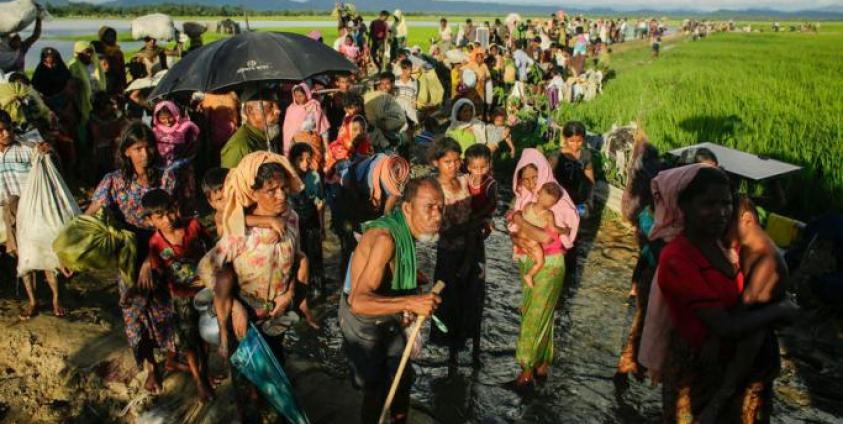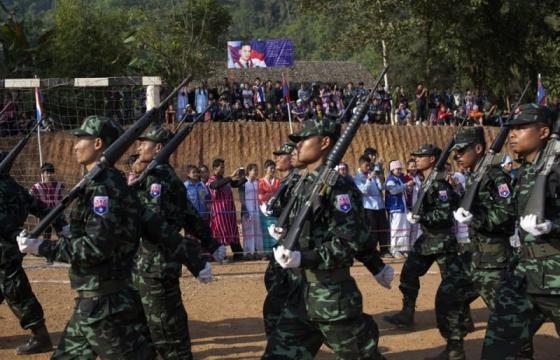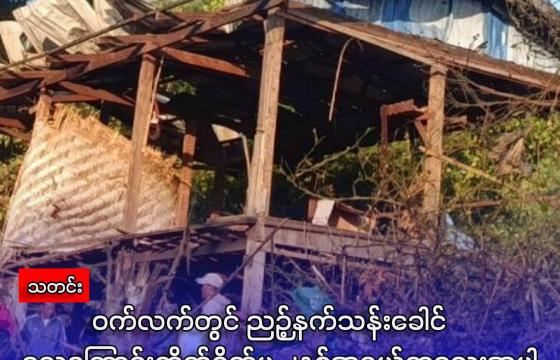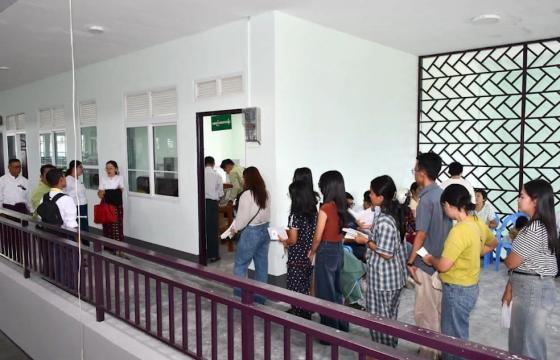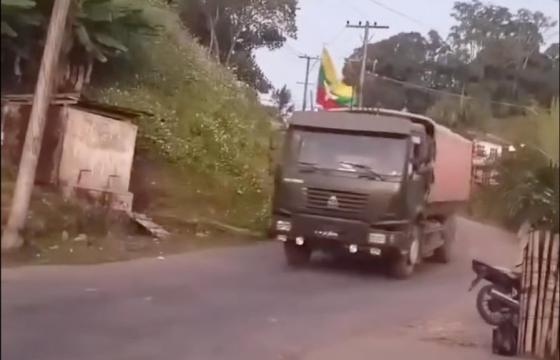Sai Wansai — Myanmar holds the dubious distinction of coming in fourth in a list of five countries in the world that drove the most people into exile, clocking in with 1.1 million refugees.
That’s not exactly good news.
The Golden Land is in rough company. The listing has Syria first with 6.7 million; Afghanistan second with 2.7 million; South Sudan third with 2.3 million; and Somalia fifth with 0.9 million, according to the United Nations High Commissioner for Refugees'(UNHCR) “Global Trends – Forced Displacement in 2018” report.
But unlike these troubled nations Myanmar woes are far more deep-seated. The country has been engulfed in civil war-like ethnic conflicts ever since its inception as the Union of Burma in 1948.
What this means is a human tragedy. Behind the face that the Myanmar authorities would like to project to the outside world are well over a million people who are displaced abroad as refugees and thousands of IDPs or internally displaced people.
Not only is this a problem that shows little sign of dissipating but it is also an issue that is seriously holding the country back from achieving its potential as an emerging democracy.
REFUGEES AND IDPS
This problem can be divided into two categories. One is the refugees, which largely affects Bangladesh and Thailand as sanctuary countries, with the lesser involvement of India and the so-called urban refugee problem in Malaysia. The other is the IDPs, who are mainly located in Kachin State and Shan State; and the newly emerged IDP population in Arakan (Rakhine) State in the western part of the country, bordering Bangladesh.
To understand these problems we have to recognize that they are a result of the armed conflict in Myanmar that can be categorized as ideologically oriented and ethnic-based uprisings, which may be coined as ethno-nationalism.
The ideologically based conflict started well before independence in 1948 from the British, which were led by the red flag and white flag communist party factions. The red flag was led by Thakin Soe and the white flag by Thakin Than Tun, both communist faction movements coming to an end in 1989.
The Karen uprising or revolution, which could be termed as ethnic conflict began in January 1949 and was the earliest, closely followed by the Karenni (Kayah) revolt. In the late 1950s the Shan and Kachin rebellion started mainly due to the dissatisfaction over the federal arrangement which the non-Bamar ethnic nationalities saw and still see it as a Bamar majority dominated unitary state, in opposition to the treaty made in 1947 in Panglong, southern Shan State, that agreed that the arrangement should be federal.
Moreover, a rebellion of the Muslims, which may either be termed as religious or ethnic conflict also erupted in northern Rakhine bordering East Pakistan (now Bangladesh) shortly after Myanmar's independence from the British rule, demanding equal rights and an autonomous area, which eventually was defeated.
The contagious ethnic rebellion eventually spread rapidly to other ethnic states and by 2009, ethnic armed organizations (EAO) had reached 21 in number pitted against the Myanmar army (Tatmadaw) troops.
This set 300,000 to 350,000 Myanmar army troops, together with its 80,000 people's militia personnel, warring against the combined 21 EAO strength of some 80,000 to 100,000. This has led to earnest armed engagements in Kachin State, northern Shan State and Arakan State, with minor clashes in Karen State since October 2015, when a partial nationwide ceasefire agreement (NCA) was signed, with eight EAO and followed another two in 2018, which now makes ten altogether.
Again in Arakan State, the Tatmadaw clashed with the Arakan Rohingya Solidarity Army (ARSA) in 2016 and 2017, the latter engagement causing over 700,000 Rohingya to flee as refugees to Bangladesh. And in 2019, the Arakan Army (AA) escalated its operation in Arakan State and the ensuing armed clashes with the Tatmadaw have so far resulted in some 100,000 IDPs according to a recent reliable report.

Karen refugees walk on a bamboo bridge while crossing a river back to Thailand after the 70th anniversary of Karen National Revolution Day at the rebel jungle stronghold in Karen State, Myanmar, 31 January 2019. Photo - Rungroj Yongrit/EPA
REFUGEES IN THAILAND
The slow burning armed conflict between the Karen National Union (KNU) and the Tatmadaw, including the lower-grade confrontation with the Karenni National Progressive Party (KNPP), dragged on for decades resulting in thousands of refugee fleeing the war zones. As of 2012, the refugee count amounted to 137,200 and by 2018 it decreased to 86,864, mostly due to resettlement and repatriation programmes, according to “Annual Report” of The Border Consortium (TBC) in 2018.
According to the UNHCR November 2019 count, the up to date refugee count is 93,206, mainly made up of Karen and Karenni ethnic groups living in nine camps in four Thai provinces along the Thai-Myanmar border.
“At the end of December 2018, 86,864 displaced people (51% women) remained in nine temporary shelters, a net decrease during the year of 7%. In 2018, around 3,390 people spontaneously returned unassisted to Burma/Myanmar, 93 returned through UNHCR led facilitated return, 2,354 departed the camps for third country resettlement, and a further 2,350 people left the camps, reportedly to seek work opportunities in Thailand,” according to the TBC report.
Because of the existing obstacles to return that relate to land tenure, livelihoods, mine clearance, and access to services in south eastern Burma/Myanmar, the return and to absorb the remaining some 86,000 refugees may not materialize in the near future. Moreover, given that the situation in Burma/Myanmar remains unpredictable and formal returns are limited, according to the report.
In this respect, TBC has been said to be “exploring potential solutions so that refugees who wish to remain in Thailand temporarily can join the legal migrant labour force until such time as they are willing to return and reintegration is feasible.”
UNDER-REPORTED CRISIS
However, one under-reported refugee and IDP crisis is taking place along the Shan-Thai border which doesn't appear on the United Nations and international non-government organizations humanitarian map.
According to Shan Human Rights Foundation (SHRF) and Shan State Refugee Committee (Thai Border) report of May 23, 2019, the present refugee and IDP situation is as follows.
The official Myanmar government narrative is that southern Shan State is now peaceful: ethnic armed groups have signed ceasefires and joined the peace process, so refugees can return and development can proceed. This is the narrative underpinning the decision by international donors to cut support for displaced Shan on the Thailand-Burma border in October 2017.
The reality is entirely different. Ceasefires are tenuous, the peace process has stalled, and armed clashes and human rights violations are continuing. Meanwhile, the two main causes of displacement in southern Shan State remain unaddressed: the Burma Army’s massive scorched earth campaign in 1996-1998, which uprooted over 300,000 people; and the forced resettlement by the United Wa State Army of over 126,000 Wa villagers to southern Shan State in 1999-2001, which pushed out thousands of indigenous inhabitants, under the former Burmese military regime’s divide-and-rule strategy.
In August 2017, SHRF produced a report “As conflict escalates in Shan State, aid must not be cut to Shan-Thai border refugees” describing the humanitarian crisis faced by over 6,000 refugees/IDPs in six camps along the Thailand-Burma border, and urging a review of the donor decision to cut food aid to these camps.
The hard-to-define refugee-IDP camps along the Thai-Myanmar border consist of six known camp sites of Kong Moong Murng, Loi Tai Leang, Loi Lam, Koung Jor, Loi Sarm Sip, and Loi Kaw Wan. Except for Koung Jor refugee camp, all the rest are within Shan State and thus are IDP sites according to the definition that refugees are those outside the country of origin and those within are IDP. It is all the more complicated on whether the IDP population at the border can also be termed as refugees, as many go in and out of Thailand to find work and even send their children to study there.
More than two years later, there has been no change in donor policy towards the southern Shan IDP/ refugee camps, despite worsening security conditions. The camps are now not even marked on UN and INGO humanitarian maps.
However, the whereabout statistics of the 300,000 uprooted displaced persons in 1996-1998 is unclear and some 6000 refugee-IDP along Thai border is hardly a realistic explanation. Some available reports in early 2000 estimated 200,000 entering Thailand, while other sources said the figure should be around 80,000. But given the empirical estimation it is safe to conclude that more than 150,000 might have entered Thailand. Thereafter, the Shan population in Thailand increased to some 1 million. Although many may be genuine refugees, others may be economic immigrants. Most blend into the Thai society one way or the other, as ethnic cousins of the Thai it is relatively easy to learn the language and integrate without much problem.
“Communities along the Nam Teng River were the primary targets for the Burma Army’s massive scorched earth campaign against the newly reformed Shan resistance during 1996-1998. Over 300,000 villagers from eleven townships were forced from rural areas into relocation sites near towns and main roads. Hundreds were tortured, killed and raped. In Kengtawng alone, troops raped 70 women and girls, including as young as five years old. The depopulation of rural central Shan State paved the way for largescale Burma Army expansion into the area – including the setting up of the Eastern Central Regional Command in Namzarng. It also paved the way for dam building,” wrote SHRF and Shan Sapawa Environmental Organization in its report “From Scorched Earth to Parched Earth - Conflict and Dams on the Nam Teng in Shan State” of December 2018.
ROHINGYA REFUGEES
The situation in northern Rakhine State is complex, as in the case of many areas of what is now Myanmar.
The Muslim Rohingya trace their history back centuries and the area is also home to the Rakhine, a predominantly Buddhist ethnic group, according to reports and studies.
As one recent media report explained, Mrauk U, the capital of the Rakhine kingdom, situated on the border between Buddhist and Muslim Asia, became one of Asia's richest, and then in 1785 came under Burmese control. The Muslim community in Rakhine expanded rapidly during colonial times, doubling from the 1880s to 1930s. Shortly after Myanmar's independence from British rule in 1948, a Muslim rebellion erupted in Rakhine, demanding equal rights and an autonomous area. But the rebellion was eventually defeated. Since then, a low-level simmering resistance goes on under various names like Rohingya Patriotic Front, Rohingya Solidarity Organization, Arakan Rohingya Islamic Front, Arakan Rohingya National Organisation, Harakah al-Yaqin (Faith Movement) and finally Arakan Rohingya Solidarity Army (ARSA).
The military coup in 1962 and promulgation of 1982 citizenship law stripped the Rohingya of their citizenship rights and the side-lining, discrimination and crackdowns followed.
The Rohingya have faced military crackdowns in 1978, 1991–1992, 2012, 2015, 2016–2017 and particularly in 2017-2018, when most of the Rohingya population of Myanmar was driven out of the country, into neighbouring Bangladesh.
Particularly the religious violence between 2012 and 2015 forced more than 112,000 Rohingya fled by boat to Malaysia. In October 9, 2016, Myanmar military counter-attack and crackdown following attacks by 300 ARSA fighter on police border posts in Rakhine State resulted in an exodus of 87,000 Rohingya fleeing to Bangladesh. On August 5, 2017, ARSA insurgents coordinated attacks on some 20 police outposts, killing 12 security officers. This was then used as a pretext by the Myanmar military to launch “clearance operations” that led to the burning down of villages and the triggering of a mass exodus of Rohingya to Bangladesh.
According to the UNHCR 31 October 2019 report, more than 744,400 Rohingya have fled to Bangladesh since 25 August 2017. These Rohingya refugees joined the some 200,000 who had fled to Bangladesh during earlier waves of violence. On 28 September 2018, at the 73rd United Nations General Assembly, Bangladeshi Prime Minister Sheikh Hasina said there are 1.1 million Rohingya refugees now in Bangladesh.
REFUGEES IN MALAYSIA AND ELSEWHERE
While the mass of the Rohingya refugee population is in Bangladesh, many have also found refuge in some 16 locations around the globe. They are according to the Rohingya Solidarity Organization data publicized by Anadolu Agency on August 24, 2019 as follows:
1. Myanmar 850,000 approximately (around 700,000 are living across the country, 150,000 IDPs in Rakhine state); 2. Bangladesh 1.6 million (around 1.4 million registered and 200,000 unregistered); 3. Saudi Arabia 470,000 (around 270,000 registered and 200,000 unregistered); 4. Pakistan 450,000; 5. Malaysia 200,000 (around 100,000 registered and 100,000 unregistered); 6. India 50,000; 7. UAE 50,000; 8. Thailand 5,000; 9. Australia 5,000; 10. US 5,000; 11. EU 3,000; 11. Jordan 1,300; 12. Indonesia 1,200; 13. Canada 1,100; 14. Nepal 800; 15. Sri Lanka 650; 16. Japan 560.
However, as of the end November 2019, there are some 178,100 refugees and asylum-seekers registered with the UNHCR in Malaysia. Some 153,430 are from Myanmar, comprising some 98,740 Rohingyas, 23,280 Chins, 9,410 Myanmar Muslims, 3,630 Rakhines or Arakanese, and other ethnicities from Myanmar, according to UNHCR.
IDP PROBLEMS
The IDP are located in Kachin, Shan and Rakhine states. But while the IDP situation in Kachin, northern Shan and Rakhine areas are well documented and reported, the condition of the southern Shan State along the Thailand-Myanmar border is under reported.
Following the 17 years of ceasefire breakdown between the Kachin Independence Army and the Tatmadaw in June 2011, massive dislocation of the population resulted in thousands of IDPs, in Kachin and northern Shan states.
The IDP total population for Kachin and northern Shan states as of 31 October 2019 by United Nations Office for the Coordination of Humanitarian Affairs (UNOCHA) is 106,234. The Shan IDP count is 8,841 and Kachin 97,393, in 171 IDP sites.
The outbreak of armed conflict in Rakhine State in 2012 and heightened escalation following the January 4, 2019 attack of the Arakan Army on government positions, 130,886 IDP in 24 IDP sites were counted by UNOCHA, as of 30 September 2019.
Thus, the Kachin, northern Shan State, and Rakhine State have a combined IDP population of approximately 237,000.
SOLUTION IN SIGHT?
Lack of peace and the non-Bamar ethnic dissatisfaction in need of a political settlement appear to be at the heart of the chronic refugee and IDP situation that continues to drag on without a resolution.
First, the repatriation of the refugee and IDP to their respective former homes has not materialized due to the lack of peace and the inability to end the protracted armed engagements in the ethnic states.
True, there have been some small scale refugee repatriation from Thailand and Bangladesh, but large scale resettlement is still not in sight. The same is also true with the deliberations to return the IDP to their homes whether they are from Kachin, Shan, Karen or Rakhine states.
The ongoing discussion between the Kachin Independence Organization and the government for the return of the IDP pointed out the necessity of a conducive peaceful atmosphere and long-lasting security guarantee of the returning IDP.
KIO spokesperson Colonel Naw Bu in August 2019 said that his organization wanted to sign a bilateral ceasefire before addressing IDP return and resettlement and that it would be impossible to cooperate before it is in place.
Likewise, the majority of the IDP also are of the opinion that peace has to be in place first before they could return to their homes.
And as such, the large scale repatriation of the Rohingya refugees, other ethnic refugees and the IDP will be feasible only after peace is achieved and framework for political settlement agreed upon.
This means, the Rohingya identity problem and security measures have to be worked out. Recently, Myanmar sent a delegation of nine along with seven representatives of the Association of Southeast Asian Nations (ASEAN) to a two-day meeting in Bangladesh’s southeastern Cox’s Bazar district to convince the Rohingya to return. But the Myanmar delegation rejection of citizenship to the Rohingya and refusal of international monitoring demand made the meeting fruitless. In addition, the Myanmar delegation offer to accommodate refugees in camps in Rakhine State instead of their former homes and give National Verification Cards (NVC) to them were rejected by the Rohingya representatives, according to recent Benar News.
Stalemate might be the best term to use to describe the refugee and IDP situation in Myanmar. The problems as discussed revolve around fierce armed confrontation in Rakhine and northern Shan states, inability to sign bilateral ceasefires between the Tatmadaw and ethnic warring groups, and stagnated NCA-based peace process all pointed to non-conducive atmosphere, which makes repatriation of IDP in ethnic states impossible.
Lack of peace and continued conflict indicate there is little hope that the refugee and IDP problem will be resolved and repatriation will happen anytime soon.
For a country that is struggling to present its best face to the world as it opens up, these are issues that need to seriously dealt with and yet are being handled poorly by the powers that be.

